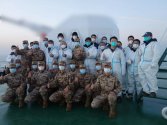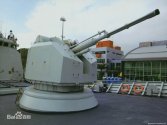I wouldn't put it like that.
Three fixed arrays is perfectly reasonable; on the Constellation class it has three reduced size SPY-6 arrays for its radar set up mounted above the deck house (but not on a mast).
In the case of 054B, the reason it will have a two array radar isn't because it's cheaper than a three array setup, rather it's because of the balance between array size, radar height, and array number.
On any given hullform, assuming money and technology isn't a limiting factor, you can only really choose two of those three things to prioritize:
- Greater array size means each array has greater power
- Higher radar height means longer radar horizon, meaning you can pick up low altitude and surface targets at longer distances
- Greater array number means you have higher refresh rates (or if you have fixed arrays, you don't need mechanical rotation for refresh)
In the case of 054B, we expect them to use the dual array mast mounted, fast rotating AESA setup:

That suggests to me, of the three characteristics from above, they chose to prioritize: greater array size (greater power), and higher radar height (longer radar horizon).
In theory, the radar is "only" two faced, but it should be on a fast rotating mount, meaning that it should have very rapid refresh rates. The overall configuration of the radar is not dissimilar to the UK SAMPSON radar on Type 45.
If on 054B they wanted to have three fixed arrays instead of two, then they have to give up one of the two other characteristics.
- They can either reduce each array's size while keeping it at the same radar height on the mast, producing a three array fixed mast mounted configuration but each array is smaller than the two array configuration
- Or, they can reduce the radar height from the mast lower to the deckhouse, producing a three array fixed deckhouse mounted configuration where each array is the same size as it was in the two array configuration, but mounted much lower on the ship thus reducing radar horizon
(and it goes without saying if they went for a four fixed array configuration, then those aforementioned factors would need to be even more diminished)
Personally, I think their current configuration of a mast mounted, large two array rotating option, is perfectly fine.
That's only for the main search radar, not counting secondary search and fire control radars.
The large dual faced AESA is likely to be complemented by a smaller dual faced AESA, which is already seen on the Type 075 and which is expected to be set on a second mast. The purpose of this smaller radar is to scan for sea skimming threats flying low over the water and the radar horizon, and this requires a higher frequency (C or X-band) for greater differentiation, resolution against targets and resistance against sea clutter. The main search radar would be the longer S-band. The implementation of the Type 364 radar in the PLAN highlights the issues of S-band radars against low flying targets amidst sea clutter.
But that's not all.
You're still going to need a set of small X-band radars set in a fixed four faced configuration (seen on Type 055) or a single array in a rotary mount, that's going to be your gunnery and antishipping fire control radars. The CIWS may have their own phase arrays too (ala Fujian 003).
And then on top of that, for the HHQ-16, you need a set of four faced X-band target illuminators that also serves to track targets while simultaneously illuminating them. (5th batch 054A).
This makes an integrated mast necessary that allows such installments, and in addition, you also need a small four faced phase array for CEC datalink and another four faced array for ESM (both ala Type 055). But we don't count them as radars. Note that the Fujian now incorporates a new four faced array ECM on its island superstructure that's an extension of the two array ECM on the 055. And that's separate from its four X-band radars and four S-band radars, along with a whole crown mast of CEC and ESM arrays.
The problem of three fixed arrays is that once the beam is bent or steered to the sides, the beam loses power and at times generate sidelobes. To reduce as much all out steering to the sides of the arrays as possible, you want four. Hence the vast majority of fixed phase array layouts prefer to use at least four arrays in four separate quadrants. This also means you can create a stronger structural tower and base that can be used to mount other arrays.
This is what you are going to expect if you are expected to replace each and every radar on the Type 054A on a one to one basis.
1. Type 382 volume air search radar -> Dual Faced S-band radar (seen on test ship 892)
2. Type 364 secondary surface search radar -> Dual faced C-band radar (seen on Type 075)
3. Type 347 Gunnery fire control radar -> X-band radar (seen on Fujian CIWS)
4. Type 366 Antiship fire control radar -> X-band radar (seen on Type 055; this can replace gunnery fire control radar).
5. HHQ-16 Front Dome target illuminators -> X-band target illuminators (seen on 054A latest batch).
We have to assume the fulfillment of these five purposes to be the base requirement of a succeeding frigate to the 054A, or you will have inferior or less capability to the predecessor.
There is a design question if you want to replace No. 2 to 5, with a single multipurpose X-band radar that does sea skimming surface search, gunnery fire control, antiship engagement and missile target illumination. This single multipurpose X-band radar is going to end up being bigger and more powerful than four separate sets of smallish radars filling the purpose of No. 2, 3, 4, and 5.
This bigger X-band radar is going to have to be a set of four arrays set on the mast below the dual faced S-band AESA. Once again, I prefer four faces instead of a three faced mast because of structural rigidity --- four supports versus three supports --- and the greater internal working volume of a square versus a triangle. Four faces on the integrated mast allow you to fit the existing four faced CEC datalinks, ESM and ECM panels on the same mast.
There is one other alternative and that is No. 2, 3, and 4 is replaced by a single X-band four faced radar, which already exists on the Type 055. This means the No. 5 is still going to be a separate set.
To sum it all up, the three radar configurations are:
One --
One Dual Faced S-band Radar for search
One Dual Faced C/X-band radar for surface search
One X-band gunnery and antiship FCR
One X-band set for missile target illumination
Two --
One Dual Faced S-band Radar for air search
One set Four fixed faced multipurpose X-band radar combining surface search, gunnery, antiship and target illumination.
Three --
One Dual Faced S-band Radar for air search.
One set Four fixed faced multirole X-band radar with surface search, gunnery and antiship.
One set Four fixed faced X-band target tracker and illumination.
Every one of these radars now exist in the PLAN inventory except for the X-band radar in Proposal 2, but even that radar is within technological possibility and would be a derivative to the X-band set already seen on the Type 055.
Last edited:


